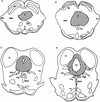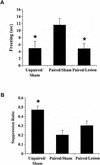Lesions of periaqueductal gray dissociate-conditioned freezing from conditioned suppression behavior in rats
- PMID: 10541469
- PMCID: PMC311317
- DOI: 10.1101/lm.6.5.491
Lesions of periaqueductal gray dissociate-conditioned freezing from conditioned suppression behavior in rats
Abstract
It is commonly assumed that suppression of an ongoing behavior is an indirect measure of freezing behavior. We tested whether conditioned suppression and freezing are the same or distinct conditioned responses. Rats were trained to press a bar for food and then given fear-conditioning sessions in which a tone was paired with a foot shock (two pairings a day for 2 days). They then received either sham or electrolytic lesions of the periaqueductal gray (PAG). Post-training PAG lesions blocked freezing to the conditioned stimulus (CS), but had no effect on the suppression of operant behavior to the same CS. Thus, conditioned suppression and freezing, which both cause a cessation in activity, appear to be mediated by separate processes.
Figures



References
-
- Blanchard CD, Blanchard RJ. Innate and conditioned reactions to threat in rats with amygdaloid lesions. J Comp Physiol Psychol. 1972;81:281–290. - PubMed
-
- Blanchard RJ, Blanchard DC. Crouching as an index of fear. J Comp Physiol Psychol. 1969;67:370–375. - PubMed
-
- Bolles RC, Collier AC. The effect of predictive cues on freezing in rats. Anim Learn Behav. 1976;4:6–8.
-
- Bouton ME. Conditioning, remembering, and forgetting. J Exp Psychol: Anim Behav Processes. 1994;20:219–231.
-
- Bouton ME, Bolles RC. Conditioned fear assessed by freezing and by the suppression of three different baselines. Anim Learn Behav. 1980;8:429–434.
Publication types
MeSH terms
Grants and funding
LinkOut - more resources
Full Text Sources
